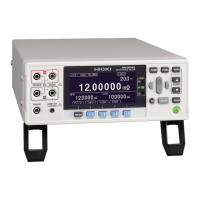3.5 Checking Measured Values
57
3
*1 Over-range Detection Function
Examples of Over-range Faults
*2 Current Fault Detection Function
Example of Current Fault
• SOURCE A or SOURCE B probe open
• Broken measurement target (open work)
• SOURCE A or SOURCE B cable break, poor connection
SOURCE wiring resistance in excess of the following values may cause a current fault,
making measurement impossible. When using measurement current 1 A ranges, keep the
wiring resistance as well as the contact resistance between the measurement target and
measurement lead low.
Over-range Detection Measurement Example
The measured value is outside of
the measurement range.
Attempting to measure 13 k with the 10 k range selected
The relative tolerance (%) display
of the measured value exceeds
the display range (999.999%).
Measuring 500 (+2400%) with a reference value of 20
The zero-adjusted value is out-
side of the display range.
Performing zero-adjustment after connecting 0.5 with the 1 range
Measuring 0.1 yields a -0.4 reading, exceeding the display
range.
While measuring, input voltage
exceed the A/D converter input
range.
Measuring a large resistance value in an electrically noisy environment
Current did not flow normally to
the measurement target.
(When the current fault mode set-
ting is set to “Over-range output”
only)
When the measurement target yields an open FAIL result
When either the SOURCE A or SOURCE B terminal suffers from poor
contact.
*To display “- - - - - - -” when a current fault occurs, set the current fault
mode setting to “Current fault.”(p.59)

